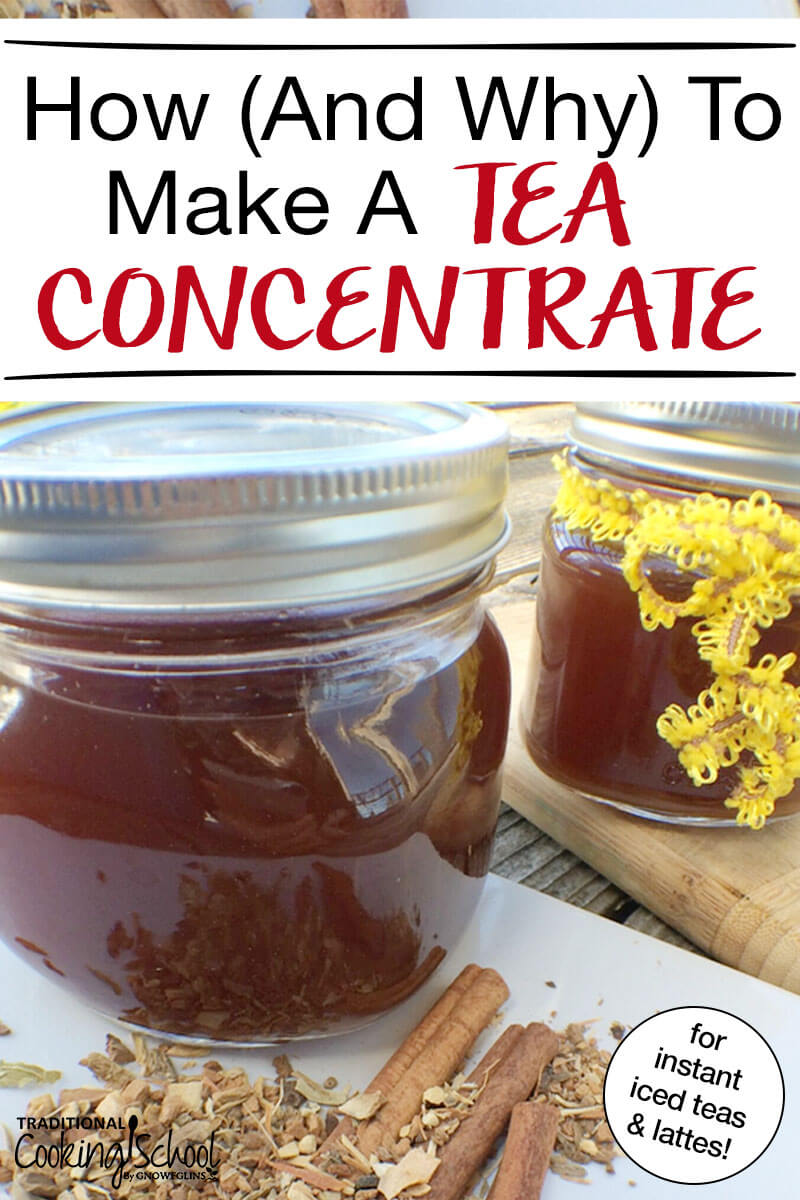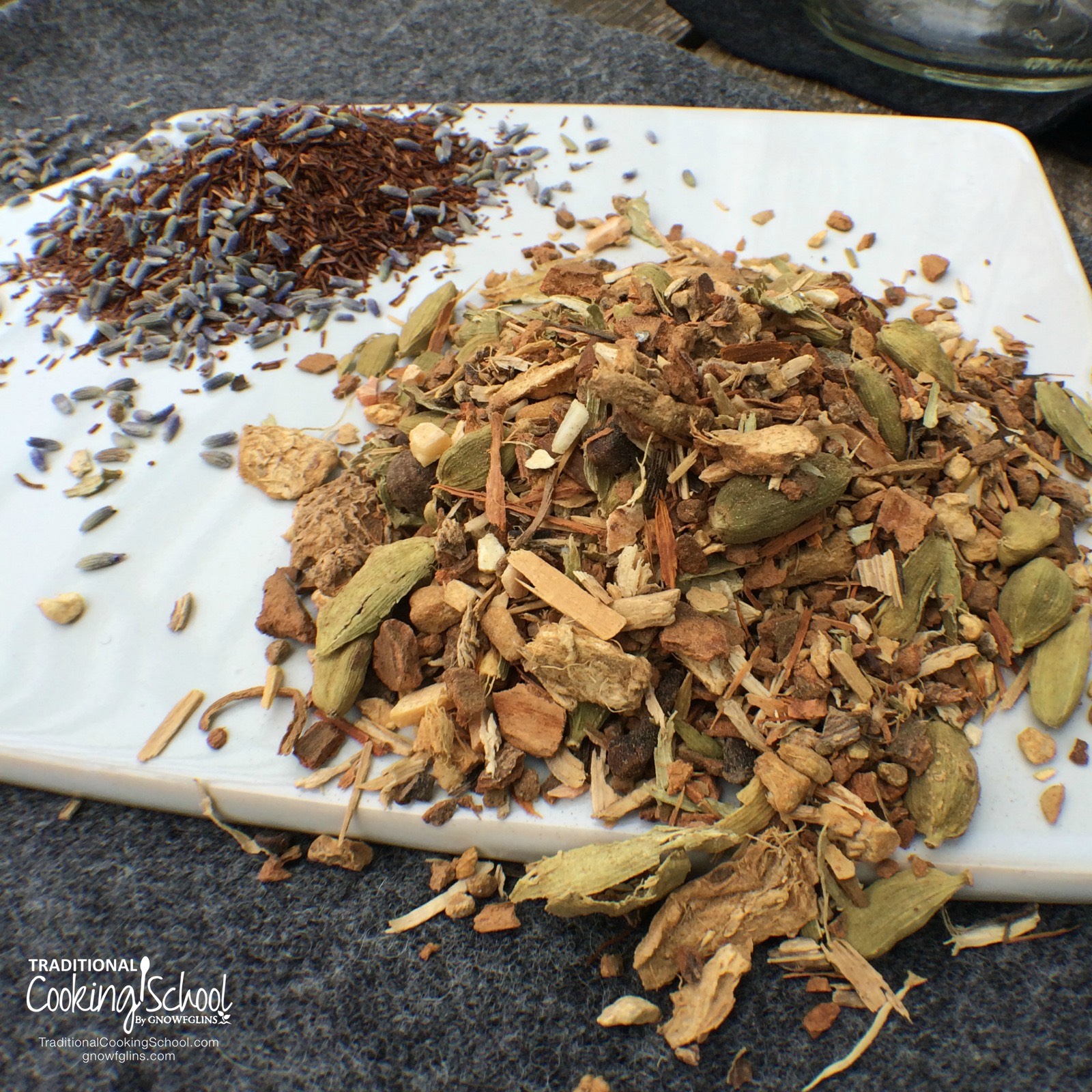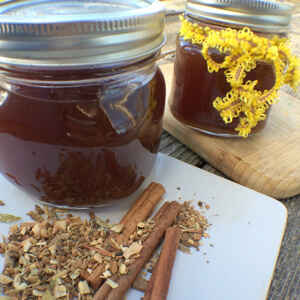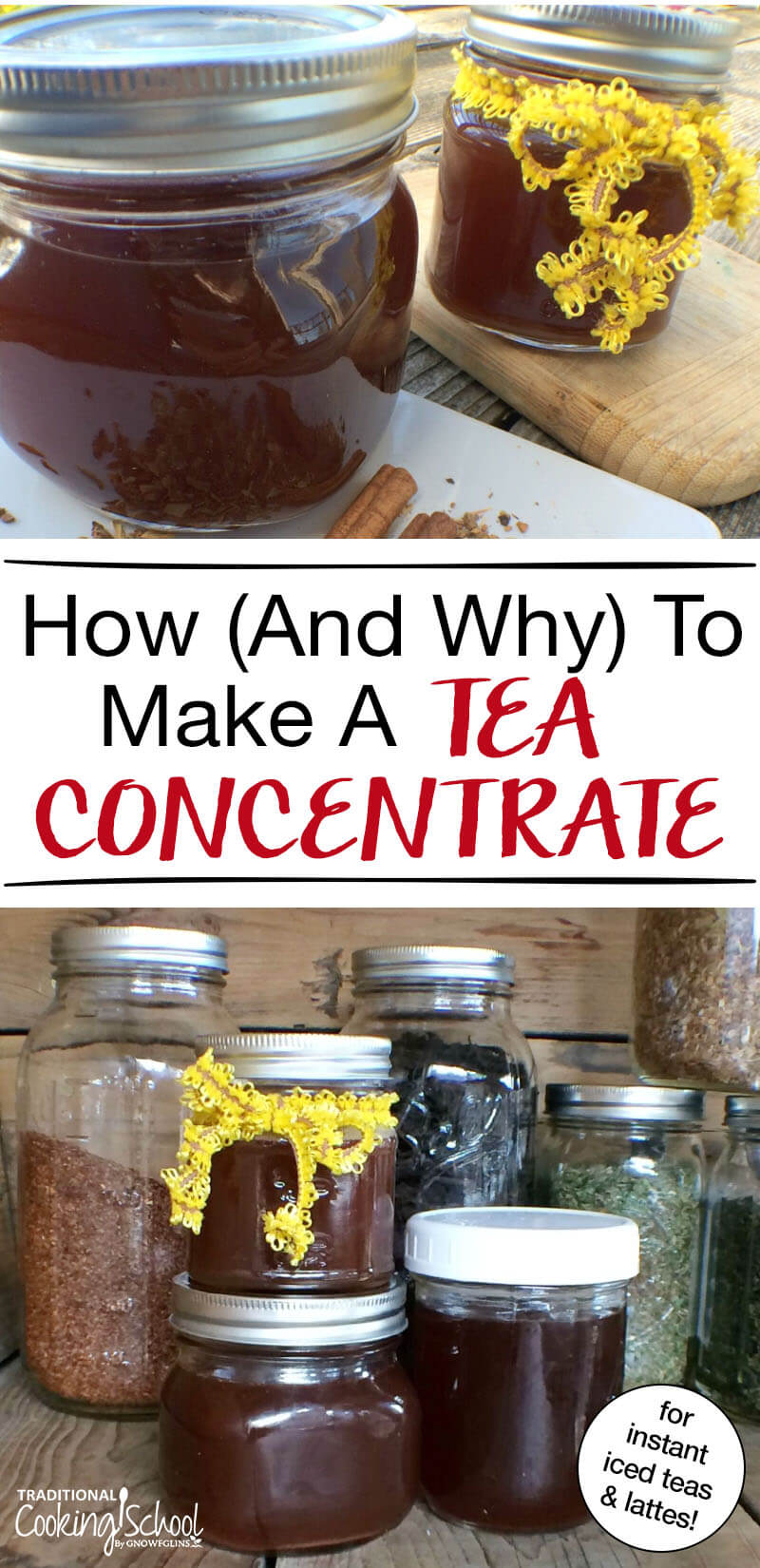
The tradition is centuries old…
Dating as far back as the 17th century in Russia, tea drinkers made tea concentrates to dilute with hot water.
This time of year, cold weather provides an excellent excuse to cozy in and give your body something hot, soothing, and healthy: a well-loved tea.
Let’s explore the many reasons why you’d want to make a tea concentrate, and then I’ll teach you how to do it!
Perfection
Firstly, the method allows you to brew the perfect cup of tea. You can be more particular than you would perhaps wish to be on a daily basis.
By going through this lovely ritual only once or twice a week, you can have the perfect cup of tea in just moments — every day.
Speed
A tea concentrate allows you to have iced tea quickly. Simply shake the concentrate, pour over ice, and add extra filtered water. That’s it!
Conversely, add hot milk to your tea concentrate for an instant latte.
Or blend your concentrate with butter and hot water for instant Butter Tea.
If the Shoe Fits
Some teas are better suited to this preparation.
Please enjoy the suspense, as next month I’ll bring you a very special segment on our new favorite tea, pu’er, which is well suited to the concentrate approach.
Rooibos and chai teas also work well with this method.
Cost-Effective
Tea concentrates are more economical.
You use fewer leaves to produce more tea.
Sweetened Tea
Concentrates are often pre-sweetened with your favorite whole sweetener, which makes them ready to go once you’ve added hot water or milk.
Sweeteners such as honey are hard to melt in iced tea. Concentrates eliminate this problem.
Decoctions
A sweetened chai concentrate is well-known, yet concentrates work similarly with other teas and herbs as well.
The healing properties of herbs, roots, seeds, and barks are harnessed in a concentrate — which provides emotional comfort and balance as well as physical benefits.
Cook with Concentrate
Concentrated tea can also be used in cooking.
Using smoky or fruity black teas, such as lapsang souchong or oolong, in marinades and salad dressings imparts amazing flavor.
Pu’er tea, which we’ll discuss more next month, can be used in soup stock.
Alcoholic or non-alcoholic cocktails can be made with tea concentrates. Rice and other cooked grains are lovely when made with tea concentrate in place of some of the cooking water.

How to Make a Tea Concentrate: Ratios, Temperatures, and Methods
The rule when making a tea concentrate is this: for every ounce of water, use 1 teaspoon of tea.
The ratio gets adjusted slightly for larger quantities. Therefore, for a quart-size Mason jar of concentrate, about 1/3 cup of tea leaves is used, depending on the variety of tea.
Teas that boil first use more water to allow for evaporation.
Interestingly, there are 3 variables that go into making the perfect cup of tea, whether it’s a concentrate or not: time, temperature, and quantity.
The temperature of the water is important.
Black teas respond well to water that is 175 degrees Fahrenheit. While this specificity may seem fussy, a candy thermometer does the trick. Skip this step if the thought of it makes you grumpy. 😉
175 degrees Fahrenheit can be spotted visually — water that has just come to a boil but isn’t yet rolling. Steep for 2 to 3 minutes.
For green tea, 160 degrees Fahrenheit is ideal, allowing 2 to 3 minutes of steeping time. The lower water temperature provides a potent brew without any bitterness. Water at 160 degrees is steaming hot, but not yet simmering, with bubbles at the bottom of the pot.
To stop the infusion, strain tea into a Mason jar by pouring it through a fine mesh strainer. Place in the refrigerator.
- When ready to serve hot tea, fill a mug 1/3 of the way with tea concentrate and add boiling water until full.
- For a tea latte, use warmed raw milk or coconut milk instead of water.
- For iced tea, fill a 16-ounce glass with ice cubes and add 3/4 cup tea concentrate. Then add filtered water to the top, or use milk for an iced tea latte.
Recipes

Lavender Rooibos
The tradition is centuries old…
Dating as far back as the 17th century in Russia, tea drinkers made tea concentrates to dilute with hot water. Try this easy and cost-effective method yourself!
Ingredients
- 32 ounces pure water
- 1/2 cup rooibos tea loose
- 2 tablespoons lavender blossoms
- 1 teaspoon vanilla extract
- 1/4 cup raw honey * optional
Instructions
The concentrate:
-
Heat water in medium size pot until it begins to boil.
-
Turn off heat and add rooibos and lavender.
-
Steep 20 minutes.
-
Strain into a quart-size Mason jar.
-
Add vanilla and honey and stir to mix.
-
Cover and refrigerate for up to 1 week.
To serve:
-
Create a ratio of one part concentrate to two parts water or milk.
-
For a sweeter, stronger tea, dilute 1:1.
-
Heat and serve.
-
Adjust the ratio of concentrate to water/milk to your liking.
Recipe Notes
- Sweetener is optional in all concentrates. The amount of honey I use may seem like a lot, but remember that the concentrate is diluted into many cups of tea. Depending on your preferences and the health benefits you want to highlight, you can use honey, stevia*, coconut sugar, sucanat, or no sugar at all. *The stevia conversion is 1/8 teaspoon for every 1/4 cup honey or other traditional sweetener.

Chai Tea: Herbal or Caffeinated
The tradition is centuries old…
Dating as far back as the 17th century in Russia, tea drinkers made tea concentrates to dilute with hot water. Try this easy and cost-effective method!
Ingredients
- 8 cups pure water
- 1/3 cup herbal chai blend
- 2 tablespoons black tea loose, or 4 tea bags
- 1/4 cup raw honey *optional
Instructions
The concentrate:
-
Place filtered water and herbal chai blend into large pot and bring water to a boil.
-
Reduce heat to medium and simmer for 30 minutes.
-
The original 8 cups water will reduce down to 3 cups tea concentrate.
-
Add black tea and steep an additional 10 minutes.
-
Strain the tea into a quart-size Mason jar and add honey.
-
Stir to dissolve.
-
Cover and refrigerate for up to 1 week.
To serve:
-
Add one part concentrate to one part water or milk.
-
Heat and serve.
-
Adjust the ratio of concentrate to water/milk to your liking.
Recipe Notes
- Sweetener is optional in all concentrates. The amount of honey I use may seem like a lot, but remember that the concentrate is diluted into many cups of tea. Depending on your preferences and the health benefits you want to highlight, you can use honey, stevia*, coconut sugar, sucanat, or no sugar at all. *The stevia conversion is 1/8 teaspoon for every 1/4 cup honey or other traditional sweetener.
AHelpful Tip
To prevent your mason jar from breaking, when pouring boiling water into it, place a stainless steel knife into the jar first.
The metal will absorb the heat and prevent the jar from breaking!
Pu’er Tea
Remember to check back next month! I’m so excited to share pu’er tea with you. I’m even bringing an expert to the conversation. We’ll share a brief video interview with one of the world’s leading experts on tea. His passion for pu’er will have you excited, too!
What’s your favorite tea? Have you ever made a tea concentrate? Do you drink tea to help bring calm to your world, for pleasure, or to help wake you up?
This post featured in 60 Easy & Nourishing Picnic Recipes.
We only recommend products and services we wholeheartedly endorse. This post may contain special links through which we earn a small commission if you make a purchase (though your price is the same).



As a Southern girl, sweet tea runs through my veins! Sadly, I don’t drink it very often now … unless I sweeten it with stevia. I do love my herbal teas; peppermint and red raspberry leaf are my favorites. I love the idea of making a concentrate though!
I like the idea of sweetening with stevia, for one’s teeth, in addition to the other more obvious reasons! 🙂 I also love red raspberry and peppermint; and they’d both make great concentrates.
I love herbal teas in the evening for relaxation and digestive tract. My favs are a mix of chamomile vanilla honey, and licorice fennel senna mixture. I drink some of each on pretty much a regular basis. truly a blessing to me when morning rolls around =) glad to have found these tasty concoctions both for taste pleasure and functional! All naturally too! #bonus. It does tend to be a bit costly & spends a bit of time preparing but still better than pharmaceutical.
Your blends sound lovely!
What inhibits Fermentation and a scobe being developed
There is not a probiotic source introduced and the concentrates are refrigerated.
I love peppermint tea with honey, vanilla and a bit of salted butter. It’s delicious, like an after dinner butter mint.
The herbal chai blend link above does not work. Can you tell me what blend you use?
Is it possible to freeze the tea concentrate? What I’d like to do is keep a supply of “tea ice cubes” in the freezer and pop them into my water bottle I carry with me to add flavour to my drinking water without adding chemicals.
Yes, you can freeze tea to make ice cubes. And for added flavor you can add frozen fruit or herbs to your tea ice cubes as well.
Can I use the powder (blue lotus chai is the brand name) to make a comcentrate? it’s what I have on hand and I’m dying to make more (no good tea shops in can find in my area)
Hi!
I just find this article and I really am interested on creating my concentrates. If I do not add any sugar or sweetener, how long will the concentrate last? do I have to keep it refrigerated?
Thanks!
I’ve been making tea concentrates for years. I drink decaf iced tea year round. Since I don’t have room for ice trays, I’ll make a concentrate and store in a mason jar. I add that to cold water in a pitcher when ready.
I’m looking forward to fresh peppermint tea this summer once it sprouts.
Hi,
Could you freeze this?
concentrated tea is best made by cold brew method
1 Cup of leaves with 64 oz GOOD FILTERED WATER
Sterilized brew container, covered
Let steep for ~16 hours
Strain into a sterilized container
Use a paper coffee filter or a good cloth or felt pad filter to remove all sediment
This concentrate will produce the smoothest tea you’ve ever tried – Never Bitter
Dilution ratios for iced tea:
Green tea ~6 or 7 parts water to 1 part concentrate
Black tea ~5 parts water to 1 part concentrate
Store in refer for days, covered of course
You’ll notice how the tea will get even smoother as time passes
So, I’ve been experimenting with making a concentrate using the sun tea method, exhausting 1 cup loose leaves, straining, and introducing new leaves for another round. Super strong, very floral (using earl grey), and hopefully recipe worthy.